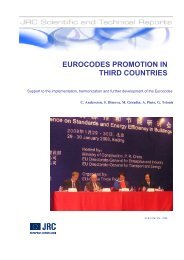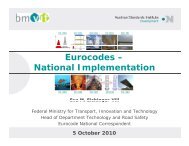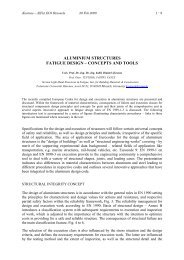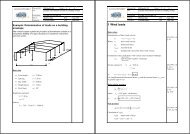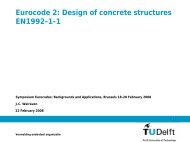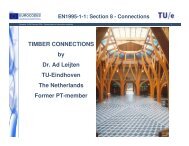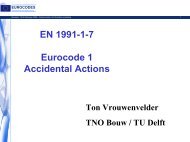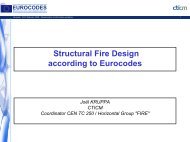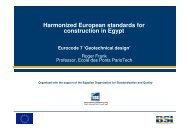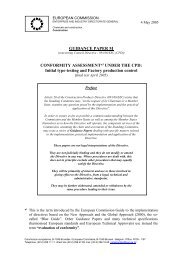Download file - Eurocodes - Europa
Download file - Eurocodes - Europa
Download file - Eurocodes - Europa
You also want an ePaper? Increase the reach of your titles
YUMPU automatically turns print PDFs into web optimized ePapers that Google loves.
Needs to achieve improvedfire protection as regards theimplementation anddevelopment of the EN<strong>Eurocodes</strong>EUR 23523 EN, 2008by J. Kruppa, G. Sedlacek, C.Heinemeyer, S. Dimova, A.Pinto, A. OztasThe work reported is a deliverable within theframework of the Administrative Arrangementbetween DG ENTR and JRC on support to theimplementation, harmonization and furtherdevelopment of the <strong>Eurocodes</strong>. The reportencompasses the results achieved during the threeyearwork on Sub-task 5.2 “Needs for fire protection”of the Administrative Arrangement.The report consists of three self-contained sections,namely:o research needs to achieve improved fire designusing the <strong>Eurocodes</strong>,o implementation and use of fire-parts of the<strong>Eurocodes</strong>, ando survey on the progress in the nationalimplementation of the <strong>Eurocodes</strong> fire design parts.The material has been prepared by the JRC incollaboration with the two ad-hoc groups on firedesign convened by the JRC and chaired by Prof.Joël Kruppa and Prof. Gerhard Sedlacek fromCEN/TC250, and in consultation with DG ENTR,Member States and individual experts andorganizations involved in fire design.<strong>Eurocodes</strong> promotion in thirdcountriesEUR 23562 EN, 2008by C. Andersson, S. Dimova,M. Géradin, A. Pinto, G. TsionisThe report constitutes a deliverable within theframework of the Administrative Arrangementbetween DG ENTR and JRC on support to theimplementation, harmonization and furtherdevelopment of the <strong>Eurocodes</strong>. The documentaddresses the need to coordinate the activities on theinternational promotion of the <strong>Eurocodes</strong> at theCommunity level and proposes a strategy and aninitial programme for their coordinated promotion inthird countries.The goals and interests of the stakeholders in theinternational promotion of the <strong>Eurocodes</strong> areanalyzed. Their convergence naturally calls for thesetting up of a framework for coordinated promotion ofthe <strong>Eurocodes</strong> in third countries. The coordinatedactions will provide considerable benefits to thestakeholders through:o putting into operation common implementationstrategy, tools and resources,o organizing joint missions involving more than onestakeholder, ando making the most effective use of the co-financinginstruments available at the Community level.A methodology for promotion of the <strong>Eurocodes</strong> in thirdcountries is put forward which aims at a better use ofthe resources available and tailored the promotionactions according to the needs of the individualcountries. The methodology encompasses:o the approach and the tools necessary forcoordinated international promotion,o the identification of target groups within a country,o the involvement of organisations/individualsinterested in the international promotion.All JRC scientific and technical reports are available todownload at http://eurocodes.jrc.ec.europa.eu.Fire resistance and single-storeybuildingsAccording to the fire parts of the Structural <strong>Eurocodes</strong>,the 3 main construction materials -concrete, steel andtimber- do not have the same behaviour whenexposed to fire.Concrete structural members, which need to rely onreinforcement steel or prestressing steel to deal withtensile forces, are fire resistant as long as the steeltemperature is below a critical value of about500/600°C for rebars and 400°C for prestressingtendons. Considering an average concrete cover ofthe steel bars of 20 to 30 mm, concrete structureshave an intrinsic fire resistance rating of 60 to 90 min,provided no spalling phenomena has occurred. Firerating of 180 to 240 min can be achieved byincreasing the concrete covering. However, from aneconomical point of view, it is generally cheaper touse fire protection material to reduce the heating rateof these elements.Due to their high conductivity, the temperature of steelstructural members is quite close to that of thesurrounding fire. In this respect, and considering acritical temperature similar to the one of rebars(500/600°C), the fire resistance rating of steelmembers is about 10 to 20 min. To achieve fireratings of 60, 120 and up to 240 min, it is generallynecessary to use fire protection coating, the thicknessof which will vary from a few millimetres to 50/60 mm,depending on the type of material and on otherrelevant parameters.3
Massive or glued-laminated timber structuralmembers, depending on the size of the cross-section,can achieve fire ratings of 60 min, provided, however,that the elements ensuring the overall stability havethe same fire resistance. For higher fire resistanceratings, the use of fire protection material is generallyneeded.Clearly, using a fire protection material leads to anincrease in the cost of the structure. This increasecould be as much as 30/40 % of the total cost.This short summary on the feasibility of someconstruction materials is only valid in the context of astandard fire exposure (so-called “ISO fire”) which isstill the basis for prescriptive regulations as far as firesafety is concerned. So we need to bear in mind thatR60 structural elements will not have an actual firebehaviour of 60 min in the event of a real fire andindeed could be very different. In addition, whendealing with the behaviour of a real building, which isthe aim of any fire regulation, other parameters needto be considered, such as the interaction betweenstructural elements and, consequently, the firebehaviour of connections. Expertise on this subject isnot consistent between the various materials: somecalculation methods like EN 1993-1.2 (steelstructures) or EN 1995-1.2 (timber structures) giveelevated temperature design rules when others suchas EN 1992-1.2 (concrete structures) do not.In such conditions, for those national regulationswhich are not performance-based, levels of fireresistance required by prescriptive regulations (ordeemed-to-satisfy provisions) will have variouseconomical consequences, depending on the materialused for the structural elements. Consequently, it isabsolutely necessary for any requirement to bejustified in terms of its need to achieve required levelsof safety for the building or civil work underconsideration.If there is no doubt that a high level of fire resistanceis needed to avoid premature collapse of multi-storeybuildings, particularly for tall buildings, the fireresistance rating for single storey buildings isgenerally unnecessary. This latter type of building isnot governed by the principle: the higher the fireresistance rating, the better the level of safety; itneeds to be assessed using fire safety engineeringtools to avoid costly but ineffective methods of fireprotection to reduce the level of risk.When regulations require the strengthening of fireresistance for multi-storey buildings, it is to ensure thelife safety of people (occupants and fire fighters)located above the fire level and also to protectproperty. However, for single storey buildings, thereare no people or property above the fire level. For thistype of building, risk analysis has to take into accountthe following:o First of all, we need to bear in mind that, if there isan increase of temperature in the fire room, it isdue to combustible content and, sometimes, tocombustible materials used for the structure andfabrics. It is never the only structural combustibleelement, if any, which can lead to a very severefire that might endanger people and property.Consequently it would be wrong to suppose that itis possible to protect property by increasing the fireresistance of the load bearing structure.o Secondly, when dealing with life and health safety,only relevant parameters should be consideredand not appropriate simplistic rules such as“egress time” or “time for fire fighters’ operation”lower than “the fire resistance time of the singlestorey building”. For people, the metric for hazardshould not refer to time but to toxic gas yield andthe amount of heat flux in the vicinity. It isimportant to remember that a hot gas layer at500°C leads to thermal flux of about 20 kW/m 2 andat 700°C to 50 kW/m 2 or so; under such thermalconditions skin burn will occur after about 1minute. Generally, it is agreed that the tenabilitythreshold is 2.5 kW/m 2 , much lower than heat fluxemitted when structural members fail.o Likewise, regarding fire service operations, it is notthe fire resistance duration which will be theharmful parameter, since the risk of failure of thestructure will occur at a level of temperature whichcannot be withstood by fire fighters. It is the extentto which the fire has developed when the fireservice is ready for action which is the key factordetermining whether or not they can enter a singlestorey building.o In particular, the overall stability of the structureneeds to be accurately considered. In the event ofa localized fire, a local failure of the building shouldnot lead to a progressive collapse which couldendanger lives or even property in areas which areaway from hot gases and smoke.A lot of national regulations have taken into accountthis specification for single storey buildings by notrequesting fire resistance rating for such works but byconcentrating requirements on egress facilities andearly fire detection and/or suppression. Noinformation, resulting from the large number of realfires that occur every year, has shown that thesekinds of prescriptive requirements are unsafe andcould endanger people. However it does appear insome countries that regulators in charge ofmaintaining fire safety regulation have forgotten thesebasic principles and are requesting fire resistanceratings of up to 120 min for an ISO fire for such singlestorey buildings.4
It is always detrimental to request inefficient methodsto decrease the level of risk, since such an investmentshould be put to much better use on more productivefire protection methods. This is more and morepertinent when considering the current economicalsituation and, in particular, sustainable development.Since it is not possible to cover all fire safety issueswith a performance-based code (which could refer tothe forthcoming ISO 23932 standard on GeneralPrinciples for fire safety engineering) and theusefulness of prescriptive codes will last for decades,it is however necessary that any prescriptiverequirement is developed in such way that:o the required objective is clearly expressed,o next, prescriptive measures relevant to thisobjective are given,o and, most importantly, it can be accuratelydemonstrated in which way the prescriptivemeasures fulfil these objectives, not only in aconventional manner, in the context of a standardfire and isolated elements, but for the overallbehaviour of the entire structure subjected to realfire, which is the sole aim of any regulation.Regulators in charge of drawing up such regulationsneed to be careful not require inconsistent fireprotection methods which have not proved adequatein reducing risks. Any other approach would bedetrimental for the construction economy by forcingbuilding owners to invest in inefficient methods whileintroducing intentional bias into the competitionbetween construction materials.Joël Kruppa,Convenor of the Horizontal Group “Fire” ofCEN/TC250 “Structural <strong>Eurocodes</strong>”Workshop “Eurocode 6 – Design ofmasonry structures”Brussels, 2-3 April 2009This workshop intends to contribute towards thetransfer of background knowledge and expertise ofEurocode 6 writers (CEN/TC250/SC6) to potentialtrainers on national level.The principal objectives of the workshop are to:o transfer knowledge and information torepresentatives of key organisations/institutions,industry and technical associations involved intraining on the <strong>Eurocodes</strong> in Member States,o enhance the training potential of the MemberStates by providing state-of-the-art trainingmaterial and background information,o contribute to the consistent and timelyimplementation of the <strong>Eurocodes</strong>,o facilitate exchange of views, networking andcooperation.The workshop is organised by the Directorate GeneralEnterprise and Industry and the Joint ResearchCentre of the European Commission with the supportof CEN/TC250, CEN Management Centre andMember States.Any individual professional interested in training onEurocode 6 may apply. However, priority will be givento participants recommended by National Authoritiesand/or National Standardisation Bodies.No registration/attendance fees are requested fromthe participants.Registration can be made online until 6 February 2009at https://jrc-meeting-registration.jrc.ec.europa.eu.The workshop programme has been defined byCEN/TC250/SC6, chaired by Prof. R. Van der Pluijm.The following topics will be covered:o <strong>Eurocodes</strong> and National Annexeso EN 1996-1-1o EN 1996-1-2o EN 1996-2o EN 1996-3o Unreinforced masonry, compressive loadingo Combined loadingo Unreinforced masonry, shear loadingo Unreinforced masonry, lateral loadingo Reinforced masonryo Calibration to obtain NDPsA “training package” consisting of the slidepresentations and the technical papers on the lecturesplus all other relevant material will be distributed to theparticipants.For additional information contact eurocode6@jrc.it, orvisit http://eurocodes.jrc.ec.europa.eu.5
<strong>Eurocodes</strong> information brokerevent in MoscowWorkshop “EU-Russia cooperation onstandardization for construction: the <strong>Eurocodes</strong>, atool for building safety and reliabilityenhancement”President Hotel, Moscow, 9-10 October 2008The Workshop “EU-Russia cooperation onstandardization for construction: the <strong>Eurocodes</strong>, a toolfor building safety and reliability enhancement” washeld on 9 and 10 October 2008 in the President Hotelin Moscow.This Workshop was organised jointly by the RussianFederal Agency on Technical Regulation andMetrology, the European Commission represented bythe Enterprise and Industry Directorate General (DGENTR) and the Institute for the Protection andSecurity of the Citizen (IPSC) of the Joint ResearchCentre (JRC), and the European Committee forStandardisation (CEN) with the financial and technicalsupport of the Technical Assistance InformationExchange Instrument (TAIEX) of the EuropeanCommission.The Workshop was undertaken in the context of theongoing Regulatory Dialogue between the EU andRussia that has been established under the EU-Russia Common Economic Space Roadmap. TheWorkshop was an information broker event forpresentation of the European Standardization andCertification System and the basic concepts of the EN<strong>Eurocodes</strong>. It was aimed to facilitate the co-operationbetween EU and Russia in reducing the divergencesin standardization and in achieving improved buildingdesign from the viewpoint of integrated safety andsecurity.130 representatives of different Russian organizationsregistered for the Workshop. They wererepresentatives of 4 Russian GovernmentalOrganizations, 15 Research Centers and Universities,6 Professional Organizations and 64 Russian andInternational Industrial Enterprises, such as Ove Arup& Partners Int., Telecom, Mosproekt,Transmagistralstroy, Foratec EnergoTransStroy, etc.The Workshop was co-chaired by Michel Géradin,Head of the European Laboratory for StructuralAssessment, IPSC, Joint Research Centre, EuropeanCommission, and Sergei Vassilievich Pugachev,Deputy Director of the Russian Federal Agency onTechnical Regulation and Metrology.Opening addresses were delivered by Michel Géradin,Sergei Pugachev and Paul Vandoren, Deputy Head ofthe Delegation of the European Commission toRussia.During the presentations and the round-tablediscussion the EU and Russian partners confirmedthe need to seek greater convergence in:o the technical regulation in the construction sector,o the harmonization of the standards and proceduresof conformity assessment,o the approach for provision of multi-hazard safetyand security, ando the reduction of technical barriers to trade.CEN/TC250 played a key role in the presentation ofthe <strong>Eurocodes</strong> and of the possibilities for technicalcooperation between the EU and Russia. Most of thelectures from the EU side were delivered by theexperts from CEN/TC250, including the Chairman,Secretary and Sub-committees’ Chairmen andmembers.The recommendations of the Workshop can besummarised as follows:1. The Construction Subgroup of the EU-RussiaRegulatory Dialogue needs to begin its workurgently, as it can best provide the political supportand framework for such convergence.2. The current EU design standards for buildings andother civil engineering works, the <strong>Eurocodes</strong>, areproposed as a starting point for convergence andcollaboration. Appropriate framework forcollaboration should be established betweenRussian Standardization Bodies and the EuropeanStandardization Committee (CEN).3. The Russian and EU partners should join efforts indeveloping a framework for collaborative prenormativeresearch projects on issues ofharmonization and use of performance-based6
standards and codes.The follow-up of the above recommendations wasproposed, including preparation of a suitable actionplan and involvement of the relevant institutions.Coordinating institutions on each side werenominated, which will communicate between themand arrange the necessary meetings, expert missionsor study visits.The Workshop conclusion and recommendationswere presented at the meeting of the Working Groupof the EU-Russia Regulatory Dialogue on 28-29October 2008 in Moscow. As a result, it was agreed tokick-off the work of the Construction Subgroup of theEU-Russia Regulatory Dialogue, which represents anunprecedented milestone.The Workshop materials are available at:http://eurocodes.jrc.ec.europa.euEvening seminar in Athens“Application of <strong>Eurocodes</strong> inbridges”20 October 2008On the occasion of the 35th meeting of theCEN/TC250 Coordination Group (CG) in Athens,October 20-21, 2008, Nick Malakatas, Chairman ofCEN/TC250/SC1, took the initiative, encouraged byJean-Armand Calgaro, Chairman of CEN/TC250, toorganize under the auspices of the TechnicalChamber of Greece (TCG) a half-day seminardedicated to the application of <strong>Eurocodes</strong> for bridges.The driving idea for this event was to take advantageof the presence of the most competent persons (SCChairmen) in Athens to participate at the CG meeting,in order to present to the Greek audience the keypoints of the Eurocode Parts related to bridges,focusing on subjects most interesting for Greekengineers, namely concrete and composite bridges,including aseismic design.The following topics have been developed:o Introduction, Traffic Loads on Bridges,Combinations of Actions (EN 1991-2 & EN1990.A2), Prof. Jean-Armand Calgaro, Chairmanof CEN/TC250o Concrete Bridges (EN 1992-2), Prof. GiuseppeMancini, Chairman of CEN/TC250/SC2o Composite Steel and Concrete Bridges (EN 1994-2), Prof. Joel Raoul, Chairman of CEN/TC250/SC4o Design of Bridges for Earthquake Resistance (EN1998-2), Eduardo Carvalho, Chairman ofCEN/TC250/SC8 and Basil Kolias, Member ofSC8/PT2o Future activities of the Horizontal Group forBridges, Prof. Steve Denton, Convenor ofCEN/TC250/HGBo General DiscussionA strong interest has been manifested for the meeting,given that 128 persons attended and all those amongthem, who answered the relevant questionnaire at theend of the meeting, expressed their satisfaction. It isinteresting to note the pro<strong>file</strong> of the participants:Staff of consulting firmsStaff of construction firmsStaff of the AdministrationAcademics (Technical Universities)Staff of software/hardware firmsStudentsNot declaredIn the two photos one can see a general view of thevery motivated audience and the CEN/TC250Chairman, Jean-Armand Calgaro introducing theseminar, which lasted over 5 hours.Prof. J.-A. Calgaro introducing the seminarGeneral view of the 128 engineers attending the seminarAs a general assessment of this event one coulddeduce that it was very successful and virtually worthyto be reproduced or imitated under similarcircumstances. Naturally, a full-day seminar wouldcertainly leave more space for the development of thetopics and the inclusion of additional ones, such assteel, masonry, timber and aluminium bridges.Dr Nick Malakatas,Chairman of CEN/TC250/SC14820121094257
International Seminar on Eurocode7 and Geotechnical aspects ofEurocode 8On 30 and 31 of October the Macedonian Associationfor Geotechnics, part of the International Society forSoil Mechanics and Geotechnical Engineering, hostedthe “International Seminar on <strong>Eurocodes</strong> 7 &geotechnical aspects of Eurocode 8” in Struga aholiday resort at the Ohrid Lake.Lectures at the seminar included the generalpresentation of Eurocode 7 “Geotechnical design”, itsapplication to spread and pile foundations as well asto retaining walls and hydraulic failure.Moreover the technical and legal questions of theimplementation of <strong>Eurocodes</strong> in the national system ofstandards of the European countries were discussedand the most important items of the National Annexesof France, Germany, Ireland, Portugal and UKpresented.The second item of the seminar was the geotechnicalaspects of Eurocode 8 “Design of structures forearthquake resistance” and the application ofEurocode 8 in the Former Yugoslav Republic ofMacedonia (FYROM).Most of the 116 participants came from FYROM butthere was quite a number coming from Albania,Serbia and Montenegro.It became clear during the discussions that the<strong>Eurocodes</strong> find a very positive response in this regionand FYROM will introduce them as quickly aspossible.Fire in RomeOn the 18th of September 2008, the Italian ministry ofInterior has organized, in Rome, a seminar to presentthe fire parts of the structural <strong>Eurocodes</strong>.This organization was made under the leadership ofDott. Ing. Lamberto Mazziotti director of the Divisionon Passive Fire Protection of the Department of FireBrigade (Dipartimento dei Vigili del Fuoco, delSoccorso Pubblico e della Difesa Civile).12 different presentations were able to illustrate thecontent of the various Eurocode fire parts(implementation, general, actions in case of fire,concrete, steel and composite, timber, masonry,robustness, statically indeterminate structures…).This seminar was well attended since more than 300persons from fire brigades, architects, designoffices… were present.Joël Kruppa,Convenor of the Horizontal Group “Fire” ofCEN/TC250 “Structural <strong>Eurocodes</strong>In-memoriam - Joachim EhrentreichThe Macedonian hosts and the lecturers fromSubcommittee 7 “Geotechnical design” of CEN/TC 250“Structural <strong>Eurocodes</strong>”Therefore the Macedonian Association of Geotechnicswas invited to take part in the discussions and themeetings of Subcommittee 7 “Geotechnical design”.Bernd Schuppener,Chairman of SC7We have received the sad news that JoachimEhrentreich, formerly official of the EuropeanCommission services in Brussels, who has renderedan outstanding work to the <strong>Eurocodes</strong> has passedaway in the age of 83 years on 6th November 2008.Joachim Ehrentreich was born in Dresden and workedwith EURATOM in Geneva before he started workingat the Commission Directorate for Industrial Services,where since 1976 he was competent for thedevelopment of a European Standard for seismicdesign of buildings and engineering works under thechairmanship of J. Despeyroux, A. Giuffre and H.Bossenmayer. A draft report was published in 1984 bythe Commission.The successful work on this standard became themodel for the preparation of the <strong>Eurocodes</strong> thatstarted in 1979 under the lead of the Commissionbefore the task, after the publication of theConstruction Products Directive in 1989, wastransferred to CEN.8
Joachim Ehrentreich was very much engaged in theEurocode work. He did not only find the leadingEuropean experts in the construction sector andsuccessfully manage the co-operation among them inorder to complete the technical work of the <strong>Eurocodes</strong>before CEN was charged with them. Due to his effortalso important solutions for technical problems couldbe found.Moreover he prepared the political decisions toestablish common unified European design codes forstructures, the necessary contracts and the mandatesfor the subsequent CEN-work. Even after retirementhe expressed his lively interest in the development of“his” <strong>Eurocodes</strong>.Joachim Ehrentreich was one of the most enthusiasticprotagonists of the European harmonisation. He wasa great European. Our sympathy is with his wife andhis family.H. Bossenmayer, J.-A. Calgaro, G. Sedlacek,CEN/TC250In-memoriam - Franco LeviProf Dr Ing Franco LeviProfessor Franco Levi, Honorary President of CEBand FIP, passed away on January 10, 2009.Born in 1914, he received his degree in Engineeringfrom the Ecole Centrale in Paris and from thePolytechnic of Turin in the years 1936 and 1937.Already assistant to Professor Gustavo Colonnetti inTurin, in 1938 he had to go into exile to France andlater on to Switzerland due to the anti-Semitic laws.Back in Italy in 1945, he could resume at thePolytechnic of Turin his outstanding research work,which was covering the most recent topics ofstructural mechanics and engineering, and publishedwell known papers and books on the theory of statesof coaction, on plastic theory, on the time-dependentbehaviour of concrete structures, with particularregard to creep effects.However, his attention was attracted since thebeginning by the need of a quick transfer of scientificachievements to the practical design and constructionof structures, and his efforts in such a direction arecertainly among the most important services renderedto the community of structural engineers in which hewas successful and for which he will be remembered.The great opportunity for that action was thedevelopment of the new technique of prestressedconcrete, in which he was scientifically involved since1938, during his first research period. After the war,since 1945 to 1961, as Director of the ResearchCentre of the CNR in Turin, Franco Levi had anessential role in the international discussion on thetheoretical and practical aspects of this innovativetechnique and on the establishment of design rules tobe internationally agreed.The innovation of prestressed concrete, together withthe new approaches of plastic design and ofprobabilistic safety criteria induced the most advancedspecialists of structural design and analysis to installin 1953 a new committee (Comité Européen du Béton– CEB) having the objective of a coordination andsynthesis of research and of the creation andinternational harmonization of the principles and rulesfor the conception, calculation, construction, andmaintenance of concrete structures according to thenew approaches.Franco Levi was appointed President of CEB from1957 and maintained this position until 1968, leadingthis organization, with his dynamic action, to thepublication of the first and the second set of CEBRecommendations.Between 1966 and 1970 he was also President of the”Fédération Internationale de la Précontrainte –FIP”,which had the role of promoting the innovativetechnique in the practical field.In 1979 the European Community considered thework of CEB ripe to become the basis for the firstEurocode; Franco Levi was appointed Chairman ofthe Drafting Committee for Eurocode 2 (ConcreteStructures). Eurocode 2 was printed by CEC in thefamous Luxemburg edition 1988, together with EC1,EC3, EC6, EC8. Franco Levi had an essential role inthe coordination of the drafting of such 5 <strong>Eurocodes</strong>based on the same criteria of the “Limit States” and onwhat was called the “Semiprobabilistic approach”.This format still remains the format of the subsequentset of <strong>Eurocodes</strong> issued by CEN TC 250 (Structural<strong>Eurocodes</strong>).The original ideas, the developments in the field of thenew safety approaches, the perseverance, theconstant attention to the new achievements of science(collected in the updated CEB Model Codes), and 40years of enthusiastic work on them made of FrancoLevi the real father of the <strong>Eurocodes</strong>.In the same time he was Professor of StructuralAnalysis at the University of Venice and at thePolytechnic in Turin and Director of the Department ofStructural Engineering and Soil Mechanics until 1989,when he became Emeritus.In 1986 he became Full Member of the Academy ofSciences of Turin.He received honours from the Universities of Liège,Waterloo, Venice, the American Concrete Institute,AICAP, and the Trasenster, Freyssinet, Mörsch,Caquot, Torroja Medals, as well as the Golden Medalof the Italian Government.For his high moral and scientific stature Franco Leviwill be remembered as one of the greatest minds instructural engineering at the international level.16-01-09Giorgio Macchi9



